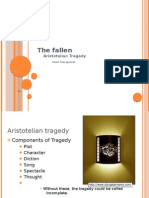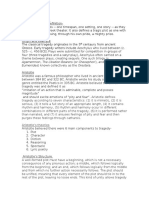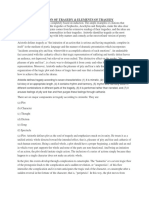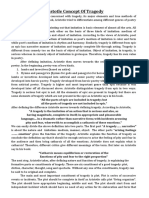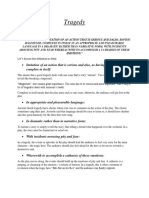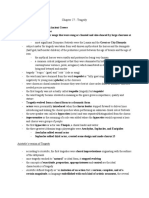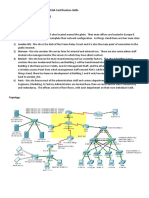Assignment
Theory of Tragedy
by Aristotle
Submitted By:
Name; Khizar Abbas
Roll no; BSKTE-22-37
Subject; English
Semester; 4th
Submitted To:
Prof.Shoaib Bukhari Sahb
—------------------------------------------------------
Aristotle’s theory of tragedy is most famously discussed in his work Poetics,
where he lays out the essential components of a tragic play. _ In simple terms,
Aristotle defines tragedy as a form of drama that aims to evoke pity and fear in the
audience, ultimately leading to a catharsis (a cleansing or purging of these
emotions).
Key Elements of Aristotle’s Theory of Tragedy:
1• Mimesis (Imitation)
Aristotle believes that art, especially tragedy, imitates life. A tragedy portrays
serious and complete actions that have a beginning, middle, and end. It should evoke
emotions that the audience can relate to, but in a more heightened or dramatic form.
2• Plot (Mythos):
- The plot is the most important element in a tragedy. It should be unified and
complete, with a clear structure.
- Peripeteia (Reversal of Fortune): This is a turning point in the plot, where the
hero’s situation changes from good to bad (or vice versa).
- Anagnorisis (Recognition): This is the moment of realization, where the
protagonist discovers an important truth, often about themselves or their
circumstances.
- The plot must be *probable* and *necessary*: It should feel inevitable, meaning
the events should follow logically from each other, and the characters' actions must
make sense within the world of the play.
3• Character (Ethos):
- Tragedy requires characters who are noble or of high social status (but not
perfect). These characters should be morally good, but they have a tragic flaw (or
hamartia) a weakness or error in judgment that leads to their downfall.
- The protagonist’s downfall must arise from their own choices, making the tragedy
feel more personal and relatable.
4• Thought (Dianoia):
- This refers to the themes or messages explored in the tragedy. The playwright
uses the plot and the actions of the characters to convey moral lessons, questions
about fate, justice, or the human condition.
�5• Diction (Lexis):
- Diction concerns the language and style of the dialogue. In tragedy, the language
should be elevated and appropriate to the characters' status. The use of metaphors,
irony, and other rhetorical devices can enhance the emotional impact of the play.
6• Song (Melos):
- The use of music or song in the play, particularly the chorus. The chorus
provides commentary on the action, often reflecting the mood or themes of the play
and can evoke emotional responses from the audience.
7• Spectacle (Opsis):
- This refers to the visual elements of the play, such as scenery, costumes, and
special effects. While important, Aristotle argues that spectacle is the least important
element in a tragedy, as it is the plot and characters that should drive the emotional
impact of. the work.
#Catharsis:
- The most important purpose of tragedy, according to Aristotle, is to arouse the
emotions of *pity* and *fear* in the audience. Through the hero’s downfall, the
audience feels pity for the hero’s misfortune and fear that the same could happen to
them.
- *Catharsis* is the process by which these emotions are purged or cleansed. By
experiencing these intense emotions in the context of the tragedy, the audience
achieves a sense of emotional release and balance.
#The Tragic Hero:
- The tragic hero is typically a person of high status, like a king or noble, but not
entirely perfect. The hero’s downfall is caused by a combination of their own flaws
(like pride, jealousy, or impulsiveness) and fate.
- The tragic hero’s journey is meant to teach a moral lesson: that even great
people can be undone by their flaws, and that recognizing one’s limitations and
mortality is part of the human experience.
#In Summary:
Aristotle’s theory of tragedy emphasizes the importance of a well-structured plot, a
protagonist with a tragic flaw, and the evocation of pity and fear leading to catharsis.
Tragedy should represent serious, complete actions and explore themes of fate,
morality, and human nature•












